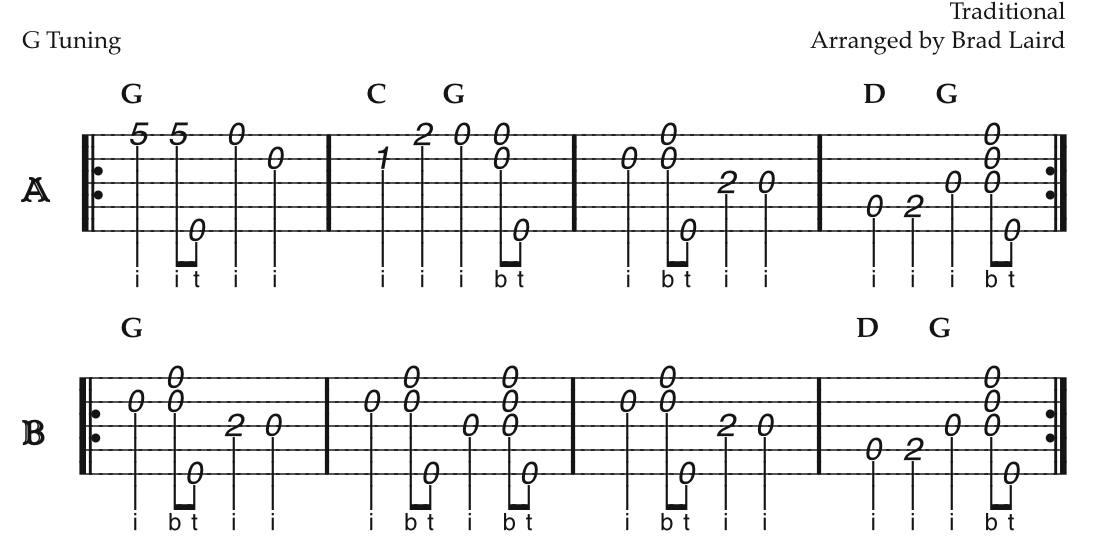|
HOME | FREE BEGINNING CLAWHAMMER BANJO LESSONS | FREE VIDEO LESSON COMPLETE VIDEO BANJO COURSE | FREE BANJO TABS | FREE PODCAST FOR STUDENTS |
||
FREE BLUEGRASS STYLE BANJO LESSONS Bradley Laird's Free Banjo Lesson site is here! FREE
MANDOLIN LESSONS Brad's Free Mandolin lessons are here.
BRAD'S JAM SESSION SURVIVAL KIT Free Chord Progression Cheat Sheets BRAD'S BLUEGRASS BASS INSTRUCTION COURSE Downloadable Bluegrass Bass Course PDF. FREE APPALACHIAN DULCIMER LESSONS Free Mountain Dulcimer Lessons
©2018 Bradley Laird
|
FREE
BANJO LESSONS - by Bradley Laird
LESSON 5 PLAYING SOME TUNES! Cripple Creek - Simplified Version Honestly, if you are of average intelligence (and I know you are probably far above the mean or you would not be attracted to the banjo in the first place!), I don't need to explain a thing about how to play this basic version of Cripple Creek. Assembling all the bits of information we've already gone over is probably sufficient for you to understand most of this. (If Google brought you directly to this page you should probably go to Lesson 1 first.) Cripple Creek - Simplified Version
However, if the neighbor's dog has been barking, or if your 3 year old (husband?) has been annoying you while you try to understand this, let me explain a few things about this tablature which might help... 1) Notice that the tab says "G tuning" in the upper left. That is the tuning explained in "Lesson 1". Bear in mind that there are quite a few other tunings which can be used in clawhammer style. 2) You will see capital letters (G, C and D) written above certain notes. These letters indicate the chord which would be played by a guitar player who might accompany you. Playing alone you can ignore those letters. 3) The tune is divided into an "A Part" and a "B Part". Each part consists of "4 measures" played twice. (See those "repeat signs"?) Put simply, play the 4 measures of "A" twice, then the 4 measures of "B" twice. That constitutes the entire tune. If that doesn't make sense go watch my videos. Now, some suggestions regarding the specifics of playing the tune... 4) In measure 1, play that 5th fret note using your left middle finger. 5) In measure 2, play those 2 fretted notes using your index for the 1st fret and your ring finger for the 2nd fret. Again, use index and ring to play those two notes. Why I want you to use those fingers is, again, fully explained in my videos. (For those who refuse to check out the videos, do it that way anyway simply because it is easier and is good preparation for things to come as you advance in your playing.) 6) The notes in measure 3 and 4 need no explanation other than I would suggest you fret those notes with the middle finger of your left hand. That takes care of the "A Part", just be sure to play it twice before moving on to "B". 7) The B Part is a little simpler and repeats some of the exact things you played in the A Part. I don't really need to explain this note-by-note or measure-by-measure (though I do that in the video course you wish I would stop talking about) but do take note of the fact that I have sometimes written the "brushes" as two notes and sometimes as three notes. You do not have to take those brushes literally. It is written that way to suggest, as I have previously stated, that you can make the brushes ANY WIDTH you choose. Incidentally, in my video lessons you will learn how to play 4 versions of Cripple Creek (and other tunes) which progressively add more techniques such as sliding, hammering on and pulling off. Then, once you have tried them all, you can mix licks from all of the versions to create the one which suits you best. OK! I have done it! I have, for free, laid out the basics of clawhammer banjo playing. That should keep you busy for a while. It could take hours for some people and months for others to absorb what I have dished out in these 5 steps. Practice at your leisure and make your goal one of getting a good steady rhythm with some measure of accuracy in your melody notes. Try to find a speed which your body, at your present skill level, seems to like as a "groove" and just keep hammering away. Try playing softly. Play flailing away at ear shattering volume. Play slowly, play quickly. Play in the dark with your eyes closed. Play while riding a unicycle. Just keep at it and, in time, you will be trying to convince your friends (if you have any remaining who have not disavowed you for abusing them so mercilessly with that "danged banjar!") to take up the banjo too! Here is another little tune for you to try. Go to Lesson 6.
| |


